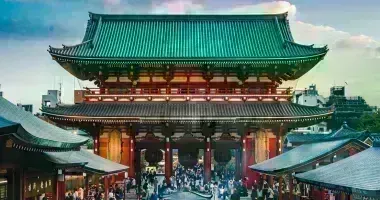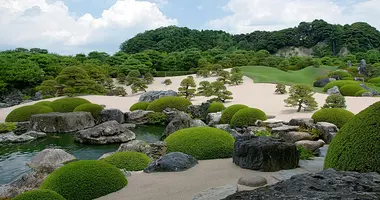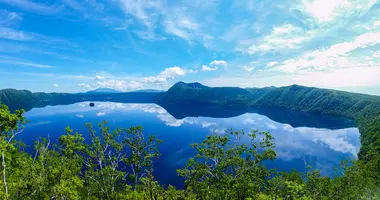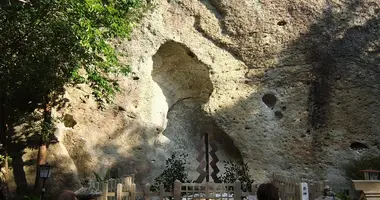Kumano Nachi Taisha Shrine
- Nachi Taisha Shrine
- Seigantoji Temple
- Hirou Shrine
- Accommodation Near Nachi
- Nachi Festivals
- Access - Getting To Nachi
Kumano Nachi Taisha Grand Shrine 熊野那智大社
Nachi Taisha Grand Shrine in Nachi in Wakayama Prefecture, is one of the three Kumano Sanzan shrines: Kumano Nachi Taisha, Kumano Hongu Taisha in Hongu and Kumano Hayatama Taisha in Shingu.
Nachi Taisha Shrine is adjacent to Seigantoji Temple and the two places of worship were basically one and same institution until separated in the Meiji Period - an example of the harmonious syncretism of Buddhism and Shinto prevalent in the mountains of Kumano.
Although worship of the Shinto kami at Nachi pre-dates the entry of Buddhism to Japan from the Asian mainland in around the 6th century, Buddhist practice soon gained a foothold in the area.
Nachi Taisha Shrine is close to Nachi Falls, at 133 meters, the highest waterfall in Japan and long a site of religious significance in Japan.

Nachi Taisha Grand Shrine

Nachi Taisha Grand Shrine
If you are walking to Nachi Taisha, rather than coming by bus, hire car or taxi, the ascent to the shrine is along Daimonzaka, (Great Gate Slope), a 600 meter long stone-paved stairway winding up through a forest of ancient, and sometimes huge, trees. The final climb is up a series of concrete steps lined with souvenir shops selling an assortment of rosary beads, straw sandals and other pilgrim paraphernalia.
Kumano Nachi Taisha Shrine
Kumano Nachi Taisha Shrine consists of a series of vermillion-colored buildings and torii gates set amidst grounds with superb views to Nachi Falls and the surrounding mountains.
The grounds contain an 850-year old camphor tree, believed to have been planted by the noble Taira no Shigemori (1138 -1179). The tree is encircled by a holy rope or shimenawa.
There is also a stone known as the karasu-ishi, the stone of Yatagarasu, a three-legged crow and helper to the legendary first emperor of Japan, Jimmu.
It is believed that originally Nachi Taisha Shrine was built down closer to the base of the waterfall. The shrine is free to enter and is open at all times, though there is a treasure hall displaying art and artifacts that is open from 8am to 4pm and charges 300 yen entry.
Nachi Taisha Shrine
1 Nachisan, Higashimuro-gun
Nachikatsuura-cho
Wakayama 649-5301

Daimonzaka, (Great Gate Slope), a 600 meter long stone-paved stairway winding up to Kumano Nachi Grand Shrine

Three Story Pagoda, Seigantoji Temple, Nachi
Seigantoji Temple
Right next door to Nachi Taisha Shrine is Seigantoji Temple though there is no real demarcation between the two. Since ancient times they were considered the same place and it was not until about 150 years ago that they were formally separated.
According to the legend it was founded by the same Indian monk who founded Fudarakusan Temple in the 4th century. As well as being part of the Kumano Pilgrimage, Seigantoji is the first temple on the Saigoku Pilgrimage that visits 33 temples dedicated to Kannon, the Goddess of Mercy, throughout the Kansai region.

Seigantoji Temple, Nachi, Wakayama
There a is a lot of statuary and several different building within the grounds, the Nyohodo, rebuilt by Toyotomi Hideyoshi in 1587, commonly called the hall of lanterns, being particularly worth a visit.
The most iconic building, and the one seen is most photos from Nachi, is the Pagoda. This version was built in 1971 to mark the three hundredth anniversary since the original burned down. It can be entered and climbed to get a closer look at the falls for an entry fee of 300 yen.
Most people prefer to take photos of the falls with the pagoda next to it in the frame though. Behind the main temple buildings is the Nakahechi, the path that climbs further up the mountains and over towards Hongu Taisha, 2 days walk away.
Seigantoji Temple
8 Nachisan, Higashimuro-gun, Nachikatsura-cho,
Wakayama 649-5301
Tel: 0735 50 401

Near the base of the 133 meter tall Nachi Falls
Hirou Shrine
The main focus of any visit to Nachi is obviously the waterfall. However, if you are walking down from the shrine and temple you will pass by car park with a Chinese-looking gate in it. If you walk up on top of what appears to be an old hotel you will find an abandoned temple with three Chinese-style buildings.
Covered in brightly painted, ornate carvings, it makes a great place for unusual shots of the falls. The falls have their own shrine at the base, Hirou Shrine, set among the ancient trees and the mist caused by the thundering water falling more than 100 meters. It is not difficult to experience awe and humility, the feelings behind the choice of this place for veneration and worship.

The 850-year old camphor tree behind a shrine gate
The Nachi area is part of the UNESCO World Heritage Sacred Sites and Pilgrimage Routes in the Kii Mountain Range. Since ancient times the area has been an important spiritual center, at first focussed on the powerful mountains and waterfall, then later as an important Buddhist site, and over the centuries millions of pilgrims made the arduous journey here.
The various pilgrimage routes that connect to the Kumano Sanzan is known as Kumano Kodo, literally "roads to Kumano". Three routes converge on Nachi. The Nakahechi Route, often called the Imperial Route as it was the one used by imperial family members and other elite pilgrims from the capital, runs north across the mountains to Hongu, another of the three Kumano Sanzan.
Running north up the coast from Nachi a relatively short route connects to the other Kumano Sanzan, Hayatama Taisha in Shingu. From there the Iseji route continues on up the coast towards the great shrine at Ise in Mie Prefecture. The other route from Nachi, heads down the coast and around the tip of the peninsula and up to Tanabe, a town known as "The gateway to the Kumano Kodo".
Accommodation Near Nachi
There are various accommodation options in the area for different budgets. On the coast around Nachi and Kii-Katsuura are many seaside resort hotels, ryokan and minshuku as well as a few business hotels. The most dramatic place to stay though is the shukubo, temple lodgings, at Seigantoji itself.
Some recommended hotels and ryokan include Katsuura Kanko Hotel, Pals Inn Katsuura, Katsuura Gyoen, Wakatake, Hotel Charmant, Yukai Resort Koshinoyu, Onsen Minshuku Kosakaya, Nakanoshima, and Hotel Nagisaya.
Nachi Festivals
The biggest festival in Nachi is held on July 14th. The Nachi Fire Festival, one of the three greatest fire festivals in Japan takes place at the base of the waterfall and involves a dozen massive torches weighing 50kg purifying a dozen 6 meter tall portable shrines (mikoshi).

Nachi-san Bus Stop
Access - Getting to Nachi
The Kumano Kodo is located south of both Osaka and Kyoto, in a rural area easily accessible by train and bus from those two cities as well as Kobe and Nagoya. From Nagoya Station it is 3 hours, 30 minutes on a Limited Express Wide View Nanki to Shingu Station. Change at Shingu Station for a JR Kinokuni Line train for Kushimoto for Nachi Station (about 20 minutes). The Japan Rail Pass is valid on this route.
There are regular flights to Osaka from both Beijing and Shanghai.
Nachi Station is on the JR Kisei Line. 4 - 5 hours from Osaka. Regular buses run from Kiikatsuura Station stopping at Nachi Station and then Daimonzaka, Nachi Falls, and Nachi Taisha Shrine.
Book Hotel Accommodation in Japan
Guide Books on Japan
Nachi Taisha Grand Shrine in Nachi is one of the three Kumano Sanzan shrines and sits in beautiful scenery near Nachi Falls, Japan's highest waterfall.



















